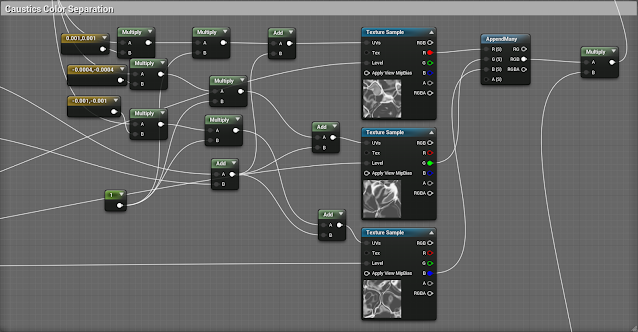Did you ever think you'd have to support gamers running 1366 x 768? According to Steam's latest hardware survey, that's what 11% of gamers are running!
Graphics settings are a pretty big deal to make sure games run and look their best, but the nitty gritty of the detailed lists with tons of options are not exactly fun to make from scratch or navigate for the user. I hate having to keep going into this menu to see the results and go back: I wanted to make a simple, easy-to-use menu in Blueprints and UMG that just works well.
The game is paused for this menu, but everything updates live and you can see it right away. Everything saves on close and reloads properly on open. Colors and graphics are not final, but this layout and functions are pretty final.
Design
The menu does not feature too many options
Quality
The logic for quality settings took a while to figure out, but the solution turned out to be quite simple: use a macro to change quality levels. Clear all check marks on initial load, then use a chain of macros to set them according to the save state. The macro has to be smart enough to activate the right buttons using selections and generate the proper console command strings. String part is easy, (console command sg.PostProcess 3), but making sure all the buttons are set properly was rather difficult! UE4 changes button names when copy+pasting, so I recommend building the buttons first, and testing and verifying everything.
I don't have the LOD slider functioning properly yet, but I intend this to adjust LOD size ratios so higher LODs get used sooner and the landscape becomes less tessellated. Since temporal AA is required for SSR translucency and more expensive temporal values create more blurring artifacts with moving foliage/water, I just set it to something agreeable permanently.
That being said, the lowest foliage and shadow settings will turn those items off completely. I'd rather disable those buttons and make it obvious the feature is required.
Resolution
Things get a lot more interesting with the resolution. Epic really likes screen percentage, so the user can drag a slider freely from 50% - 100% the desktop resolution (Actually updated screen resolution by copying all global post process settings and only changing the resolution. There may be an easier method now...). Once the value is committed the system uses the desktop resolution and rounds to the nearest whole pixel on the Y axis. This ensures the sharpest image possible. The actual resolution is displayed up top and updates live. I also have buttons for predetermined common resolutions: though BP does not have access to properly changing both X and Y resolutions (and Epic really encourages percentages instead of setres), I still like the feeling of making a physical selection. It only uses Y values for calculations. When players see the buttons only drag the slider, they may be more inclined to just use the slider outright. Best of both worlds, and a great example of informing usability! Why don't more menus do this?
There is a method to my 5 common resolution choices:
| HD |
1280 x 720 |
921,600 |
| HD+ |
1600 x 900 |
1,440,000 |
| Full HD |
1920 x 1080 |
2,073,600 |
| QHD |
2560 x 1440 |
3,686,400 |
| 4K |
3840 x 2160 |
8,294,400 |
According to Steam's June 2019 hardware survey, 65% of users play at 1080 "full" HD, but a whopping 11% still play on 1366 x 768. Since this resolution doesn't divide down nicely, I'll expect those gamers to use the slider. 2560 x 1440 represents 5% of users, and the rest get less popular from there. 1600 x 900 is the most commonly used step between 720 and 1080 (3.2%), and I had to include 4K (1.6%) as the highest possible option.
Framerate
And finally, an option I don't see in any PC games: a framerate cap! At first glance it seems like a terrible idea, but games on consoles have been doing this since the dawn of time to fix erratic performance. Most 30f games can actually run faster at certain points, but overall the rate is too unstable to leave open. Capping stabilizes things tremendously, even/especially on gaming monitors, so it should be featured more frequently.
Results
Overall, this is one of the most streamlined and easiest-to-use graphics menus I've ever seen. It's so fun to see the resolution go up and down on a paused frame and watch the results instantly! And setting the framerate cap to 60 on a gaming monitor to get perfectly stable performance feels great! If more menus were designed like this, they wouldn't be so clunky, difficult to understand, or frustrating to figure out and use. Everything should just work perfectly.










































